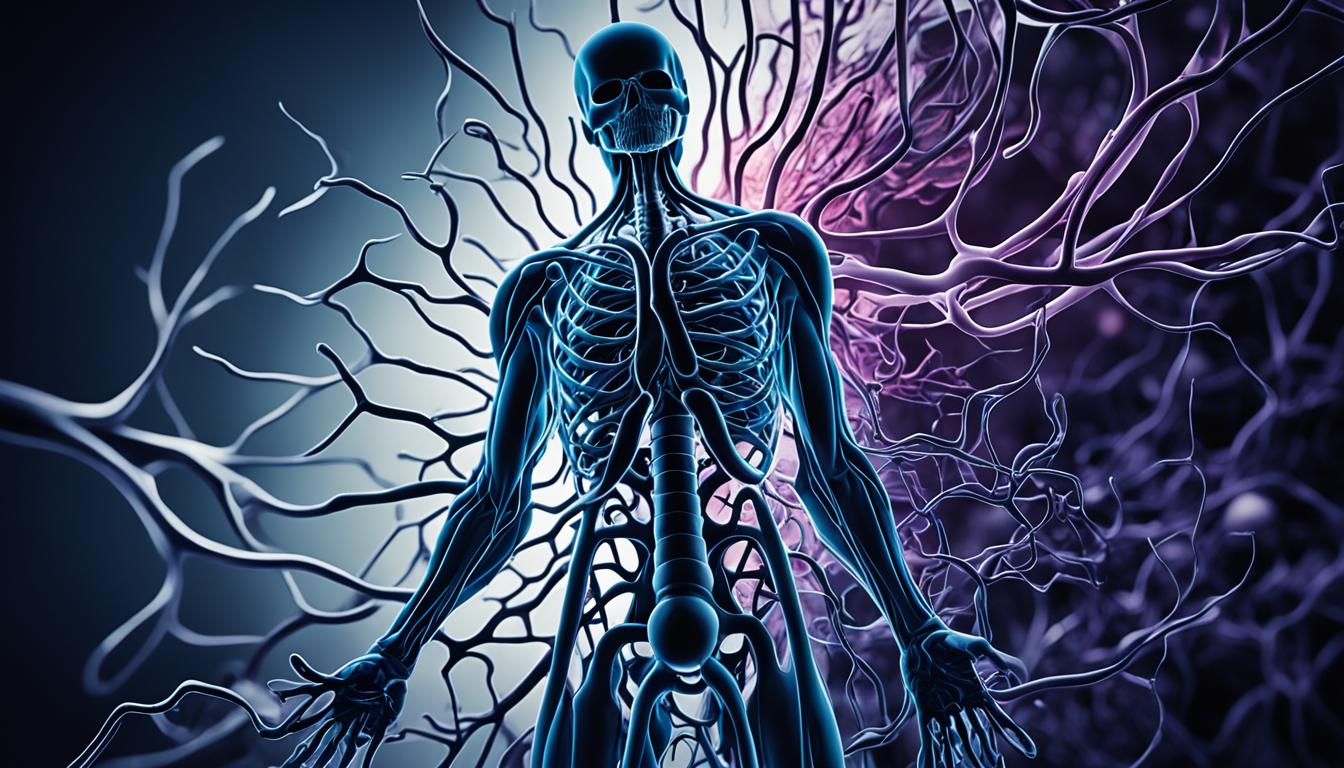Bladder cancer is when tissues in the bladder grow abnormally. This can lead to tumor formation. Types of bladder cancer are adenocarcinoma, squamous cell carcinoma, and transitional cell/urothelial carcinoma. Symptoms often include blood in the urine, the need to urinate a lot, and pain when urinating. It’s not entirely clear what causes bladder cancer. But, a mix of diet, chronic bladder infections, smoking, age, race, and chemical exposure may up the risk. Diagnosis and how doctors treat it depend on how far the cancer has spread.
Key Takeaways:
- Bladder cancer is the abnormal growth of tissues in the bladder.
- Common symptoms include blood in the urine, frequent urination, and painful urination.
- Certain factors, such as diet, chronic bladder infections, smoking, and exposure to chemicals, can increase the risk of bladder cancer.
- Diagnosis and treatment options depend on the stage of the cancer.
- Stem cell therapy shows promise as a potential treatment option for bladder cancer.
Symptoms and Diagnosis of Bladder Cancer
Bladder cancer shows itself through specific symptoms. It is diagnosed with certain methods. Catching the signs early helps with fast treatment. Let’s take a closer look at the symptoms and diagnostic steps for bladder cancer.
Symptoms of Bladder Cancer
Bladder cancer signs can seem like other, not so serious, health issues like UTIs or urinary stones. But if these appear, pay attention:
- Blood in the urine (hematuria)
- Frequent urination
- Painful urination
If you notice these symptoms, get medical help right away to find out what’s happening.
Diagnosis of Bladder Cancer
To diagnose bladder cancer, several tests are needed to be sure. Here are the tests used:
- Urine tests: These look for infection markers, red or white blood cells, or abnormal cells in the urine.
- Imaging tests: Tools like ultrasound or CT scans show detailed images of the bladder. They help spot any issues or tumors.
- Cystoscopy: A thin tube with a camera is used to look inside the bladder. This lets doctors see if there are any cancer signals.
- Biopsy: Sometimes, a small piece of bladder tissue is taken out for a closer look under a microscope. This confirms if there are cancer cells.
By doing these tests together, doctors can precisely diagnose bladder cancer. They can also tell the cancer’s stage. This information is crucial for planning the right treatment.
| Diagnostic Method | Purpose |
|---|---|
| Urine tests | To detect abnormal cells, infection markers, or blood in the urine. |
| Imaging tests | To visualize the structure of the bladder and identify any abnormalities or tumors. |
| Cystoscopy | To directly observe the inner walls of the bladder and detect any signs of cancer. |
| Biopsy | To collect a tissue sample from the bladder for microscopic examination and confirmation of cancer cells. |
Causes and Risk Factors of Bladder Cancer
Nobody knows the exact reason why bladder cancer happens. But, we do know about several things that can make it more likely. These are called risk factors.
Causes of Bladder Cancer
Bladder cancer can come from a mix of genes, the environment, and how we live. Some things that are often connected to bladder cancer are:
- A diet high in saturated fat: Foods rich in saturated fat, like red meat and high-fat dairy, may raise your risk.
- Regular intake of certain herbs or medications: Some herbs and medicines might harm bladder cells, making cancer more likely. Always talk to a doctor before taking anything new.
- Chronic bladder infections: Bladder infections that keep coming back can irritate the bladder. This may help cancer grow.
- Smoking: Smoking is the top risk for bladder cancer. Chemicals in tobacco can hurt your DNA, upping your cancer risk.
Risk Factors for Bladder Cancer
Not everyone with these risks gets bladder cancer. But understanding them can help lower your chances. These factors are important:
- Age: Bladder cancer is often seen in those over 70. The risk goes up as you get older.
- Ethnicity: Caucasians face a higher risk of bladder cancer than many others.
- Family history: If someone in your family has had bladder cancer, it could mean you’re at greater risk too.
- Long-term exposure to certain chemicals: Working with certain chemicals or drinking water with arsenic can up your risk. This is common in dye, rubber, and leather jobs.
- Treatment of other cancers: Cancer treatments like radiation or chemotherapy can sometimes lead to bladder cancer.
Knowing the causes and risks helps with prevention and early detection of bladder cancer. Leading a healthy life, avoiding harmful chemicals, and having check-ups can keep you safer.
Stem Cell Therapy for Bladder Cancer
Stem cell therapy is gaining ground as a new way to treat bladder cancer. Recent studies suggest that stem cells can become bladder cells. This opens the door to growing new bladder tissues.
Especially, mesenchymal stem cells show great promise. They can come from fat or bone marrow. These cells have shown the potential to help repair the bladder’s function.
In the search for new methods, researchers are also looking at how stem cells can help regenerate the bladder’s inner lining. This finding may lead to new ways to fix damaged bladder tissue.
There’s still a lot to learn about using stem cells to fight bladder cancer. But these early discoveries bring hope. They hint at better treatments and the possibility of major advancements in the future.

